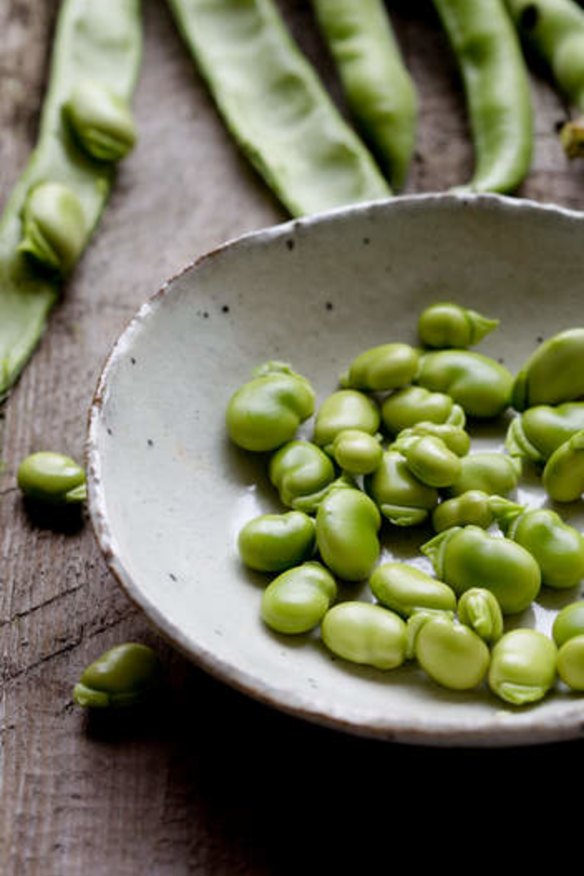Fava beans: what are they?

What are fava beans and where do I get them? C. Baker
They are broad beans. While broad beans refer to the green beans still in the pod, fava beans also refer to the dried version used in dips and stews. Broad beans are the beans native to northern Europe, having been cultivated at least 5000 years before present times. The smaller beans, such as the navy bean, are recent arrivals from Latin America. In the Romance-language countries they use derivations of the Latin word ''fava''. In Italy, a broad bean is fava; in France, feve; in Portugal, fava; and in Spain, haba. In the US, they use the Italian word fava. In Australia we use the English term ''broad bean'', from the Germanic tradition. Look for fresh broad beans at greengrocers and farmers markets and dried broad beans at Mediterranean delis.
Could you please let me know how clumping of brown sugar occurs, how to avoid it and to remediate the situation when it occurs. R. Parsley
We went straight to the horse's mouth for this one and here is the response from Ron Weibrecht, the quality manager of manufacturing at Sugar Australia. ''Brown sugar is a naturally moist product. It has a generous layer of syrup around each core crystal. If not stored correctly, such as in dry, warm conditions, this syrup layer will dry out and the brown sugar will form clumps. To overcome a clumped product, one recommendation is to place a single slice of apple overnight in the container with the brown sugar. That will make it moist and soft again.'' He went on to add, ''I could give you a more technical response, but I'm sure that would be too much for your readers!'' What do you think, readers? Do you think technical information is beyond your grasp? Or do you prefer to be kept in the dark about clumpy sugar? Let us know.
I have a nondescript set of six kitchen knives, which invariably lose their sharp edge and become frustratingly blunt. This is despite using both a stone and a steel in an attempt to keep them razor-sharp. P. Fenton
I have two young children. When they have been exposed to a TV ad and ask for some product/toy/visit to an attraction, my reply is, ''Anything you really need is never advertised on the telly,'' or something like that, which they ignore anyway. Never buy knives advertised on television, as they usually go blunt once the ''on air'' light goes off. In life you need one good knife, such as a German- or Japanese-made knife with the blade and handle forged from a single piece of steel. Start off with an eight-inch chef's knife. The true secret to sharp knives is behaviour. Susan Hawes of Scullerymade in Melbourne says, ''Once a fortnight you need to sharpen your knife on a stone using honing oil. Then, the crux of the matter is that every time you use, you remove your knife from the block or magnetised strip, and you must sweep the blade over a steel, six to eight times on each side of the blade. The knife should be angled 18 to 20 degrees from the stone.'' For knife classes, try Chef's Armoury (chefsarmoury.com) in Sydney and Melbourne; Paris International Cooking School (picssyd.com.au) in Sydney; and, in Melbourne, the Essential Ingredient (essentialingredient.com .au). Walter Trupp Cooking School (truppcookingschool .com) in Prahran is running a knife skills class this Saturday, September 14, for $220.
Why does food taste funny after I have eaten artichokes? M. Braley
When you chew artichokes, one of the phenolic compounds found in artichokes, cynarin, is released and tends to inhibit the receptors on your taste buds that perceive sweetness. So when you follow a mouthful of artichokes with something different, the cynarin is swept off and all of a sudden you can taste sweet again and so, by contrast, whatever is in your mouth tastes sweeter, which is why many sommeliers despise chefs putting artichokes on the menu. There is a restaurant in Jerez de La Frontera in Spain called Bar Juanito that serves a dish called Alcachofas Juanita - artichoke hearts cooked in olive oil with onion, garlic and breadcrumbs. It's deliciously moreish, particularly with sherry, as the cynarin seems to have lost its potency during the cooking in oil. I tried this dish with several different types of beer and sherry and they seemed quite untainted by the artichokes. I also found that after the beer and sherry not only did my Spanish improve but also my ability to flamenco dance.
Is there a cooking conundrum you'd like solved? Leave a question for Richard Cornish in the comments below, or email him at brainfood@richardcornish.com.au
The best recipes from Australia's leading chefs straight to your inbox.
Sign up- More:
- Brain food
